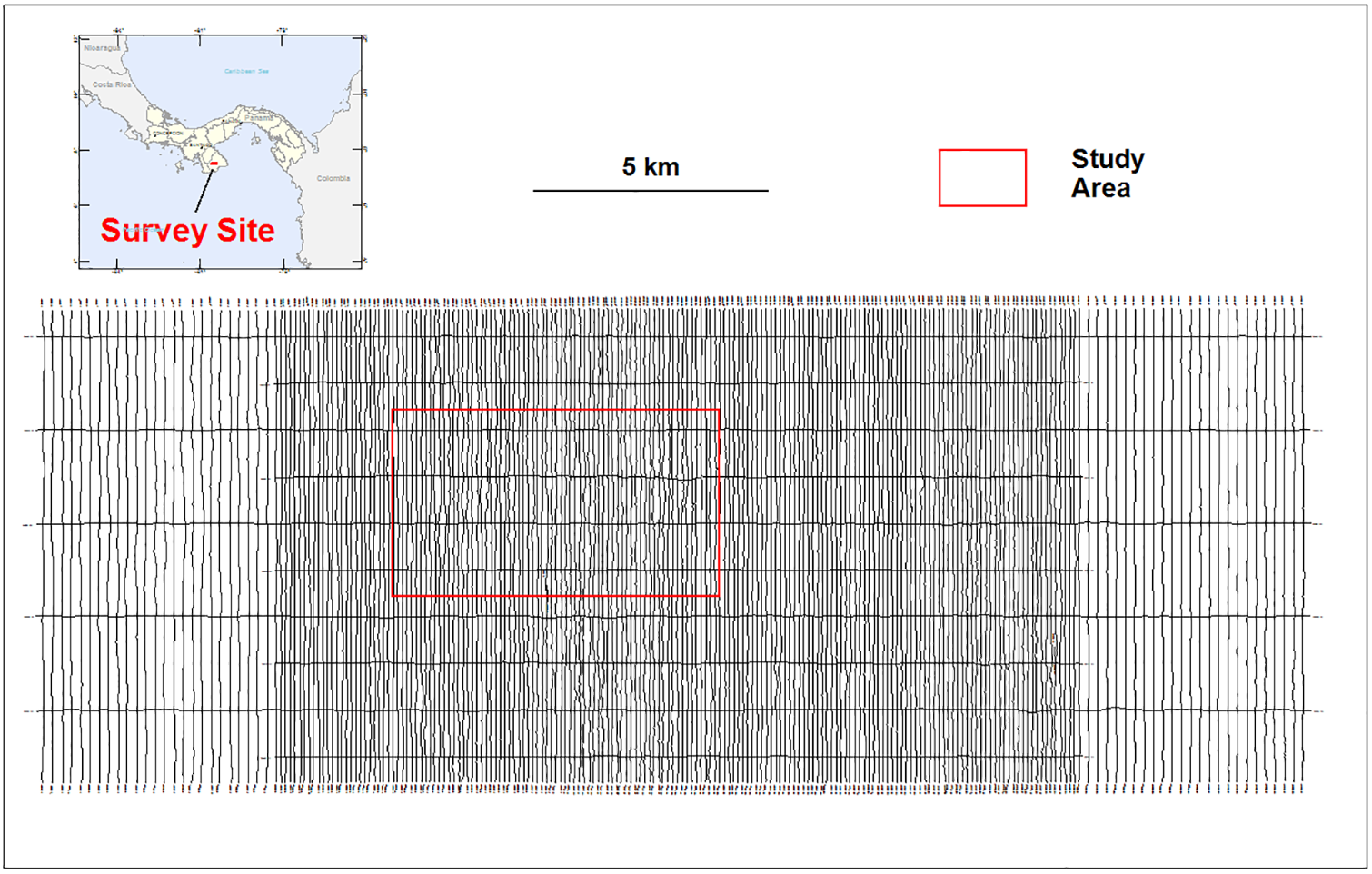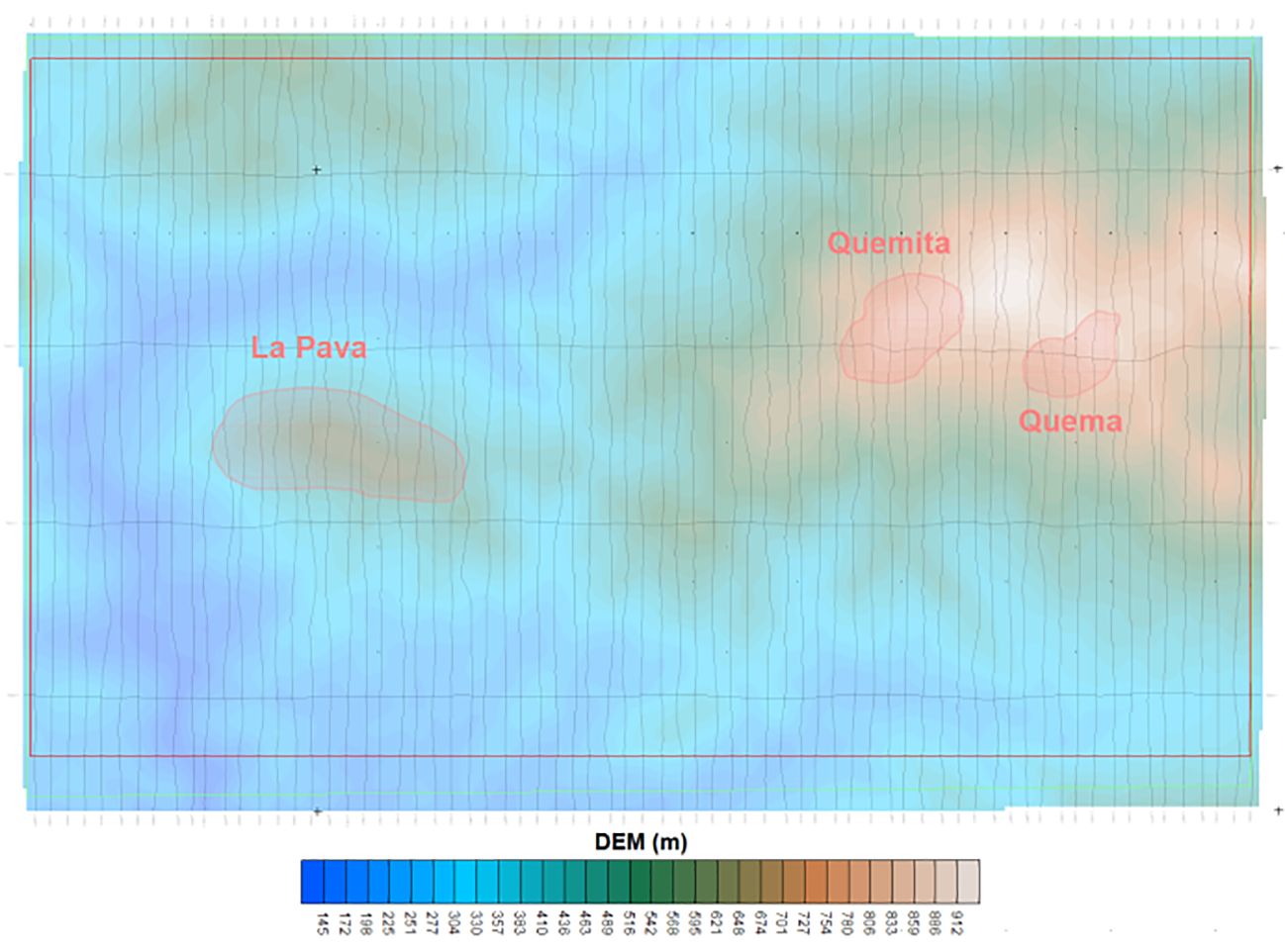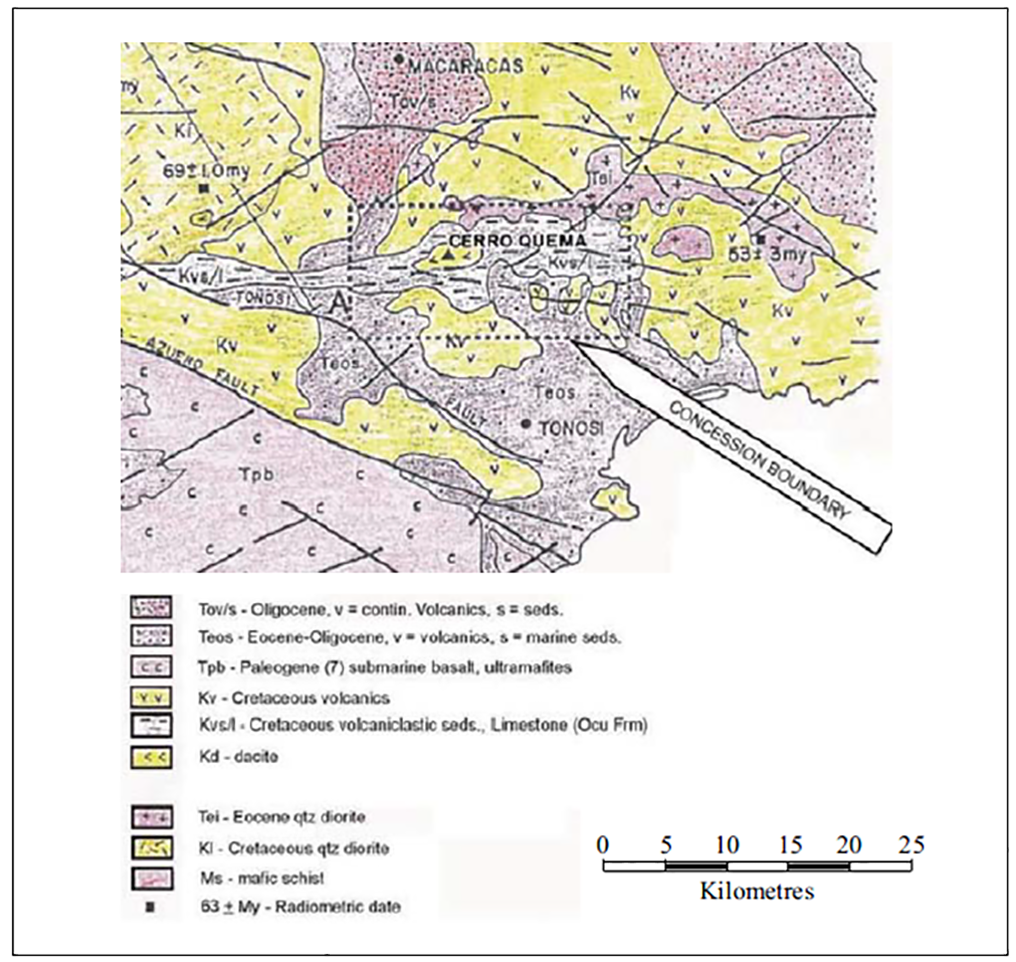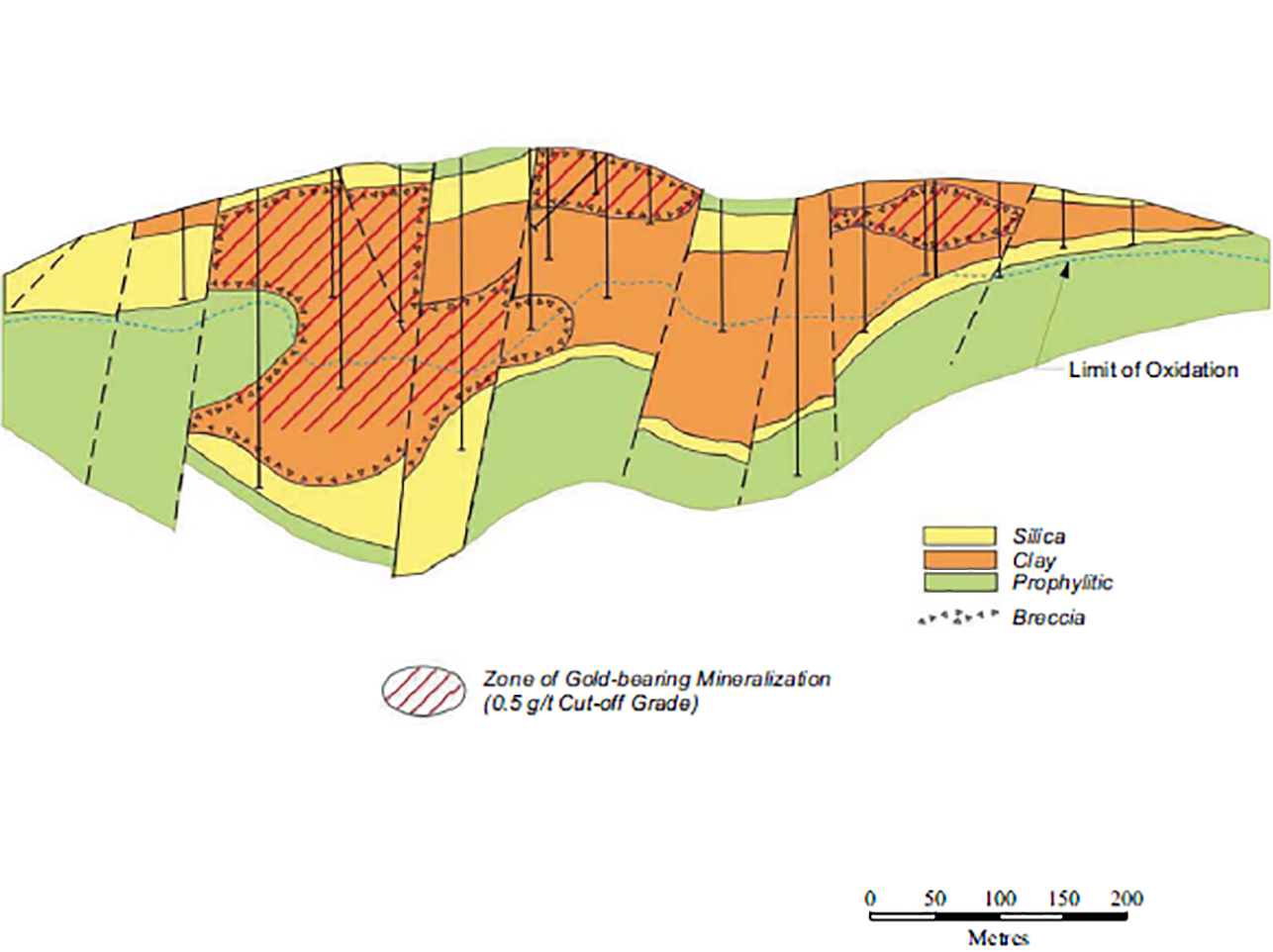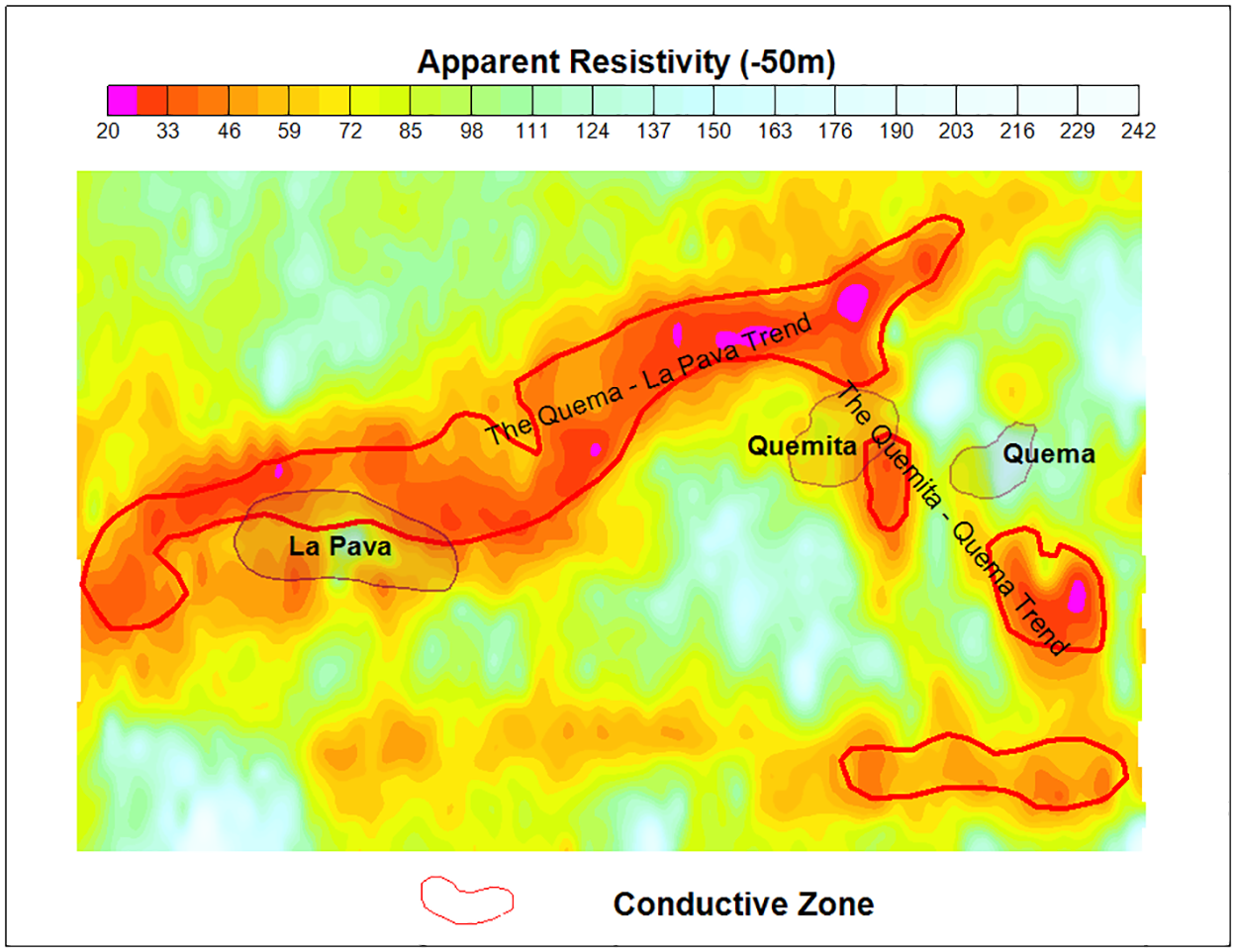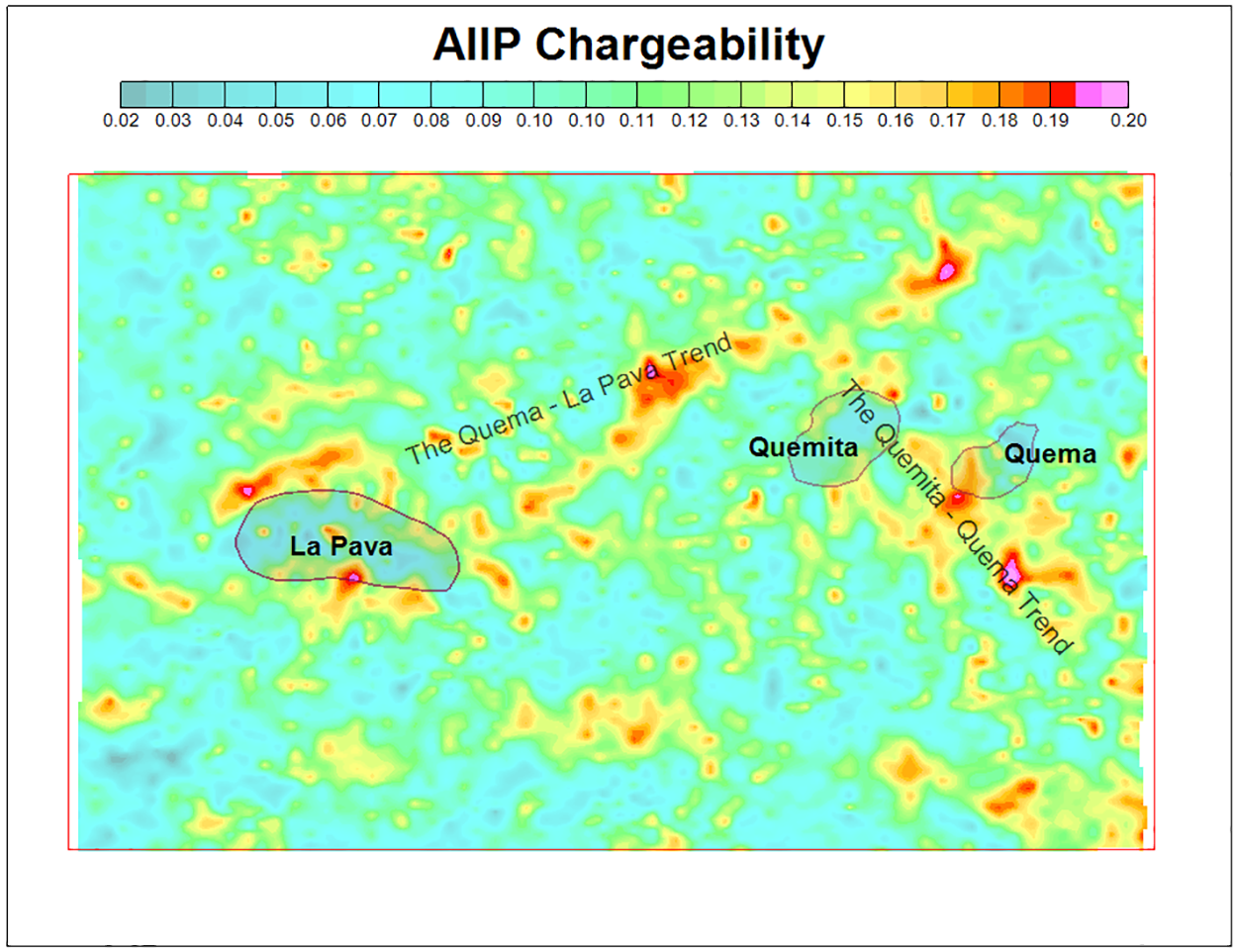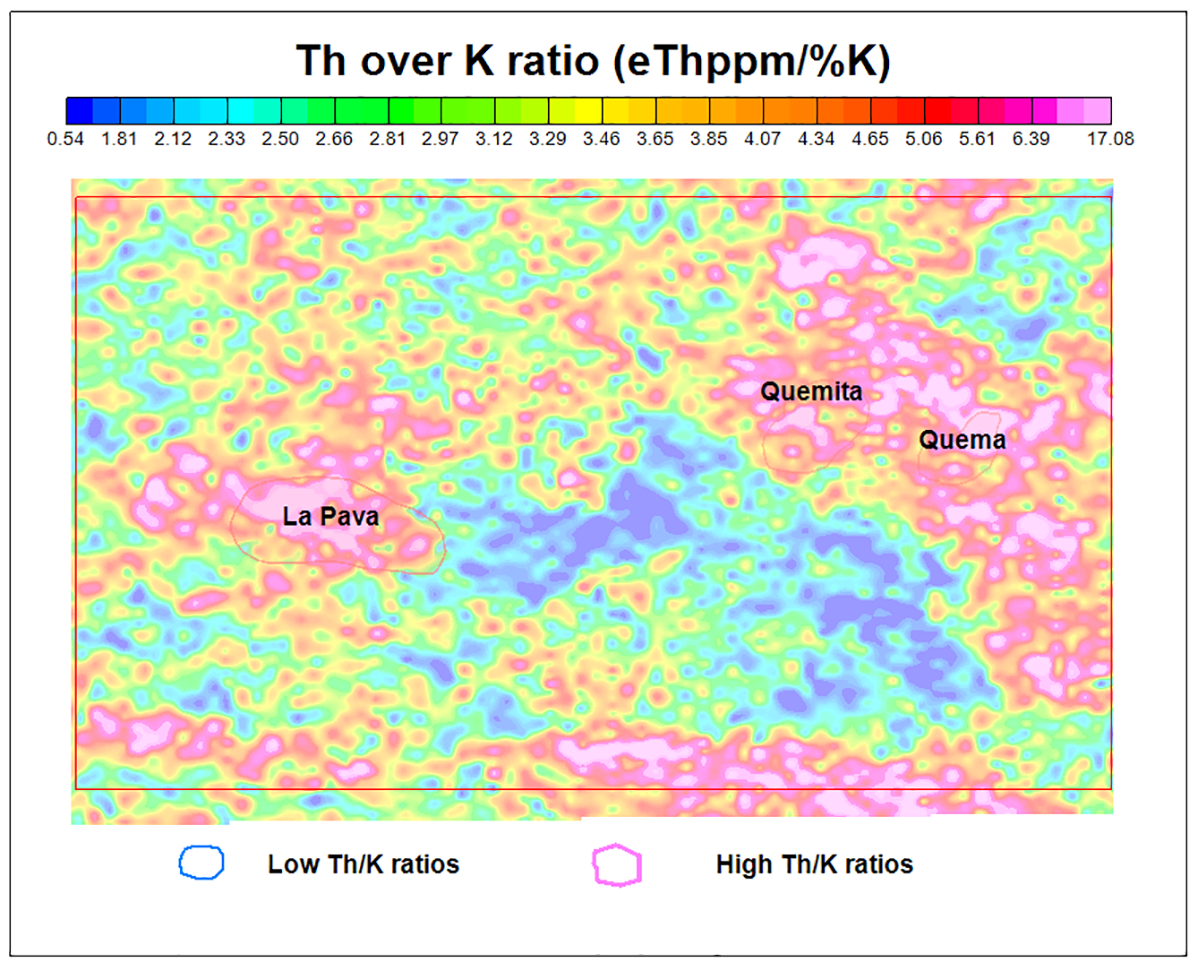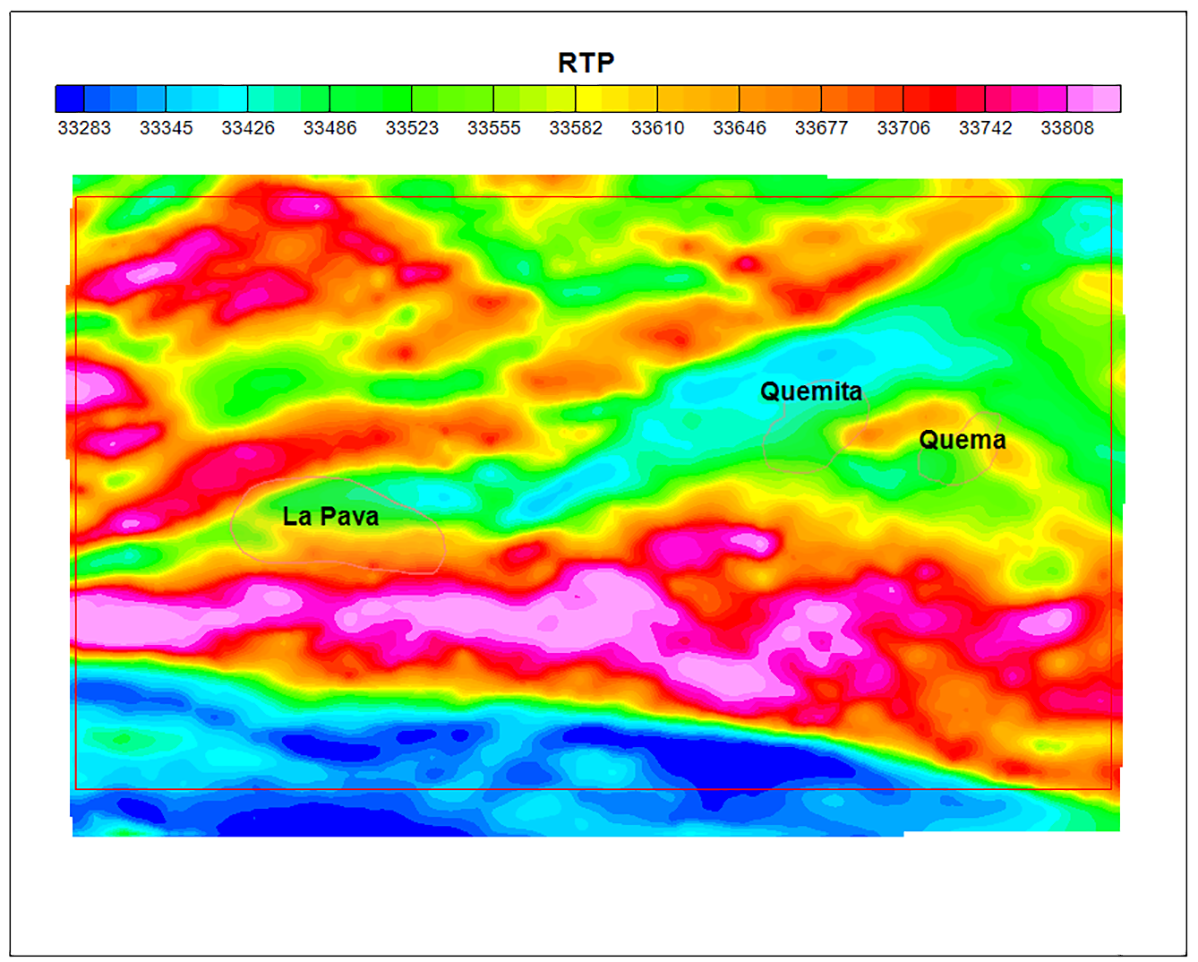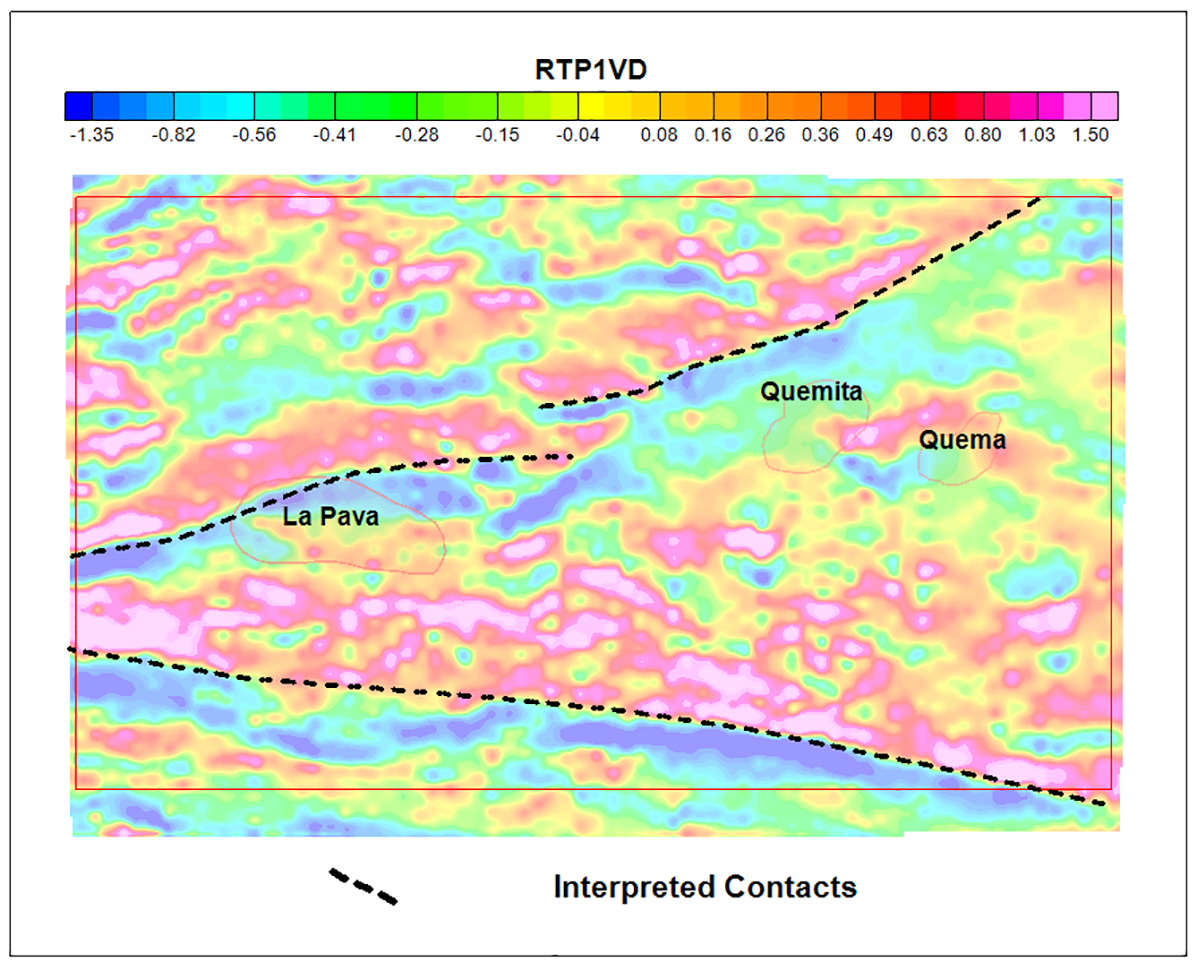Presented at ASEG-PESA 2015 – Perth, Australia
For a PDF of this paper click here
Summary
In March 2012, a helicopter-borne VTEM electromagnetic (EM), magnetic and radiometric survey was flown over the Cerro Quema high sulphidation epithermal gold deposits in Panama. Geophysical signatures, including Airborne Inductive Induced Polarization (AIIP) effect, characteristic of high sulphidation epithermal gold deposits were observed in the EM, magnetic and radiometric data over the known deposits. This success points to the applicability of regional helicopter EM-Mag-Spec surveys for the exploration of similar high sulphidation epithermal gold deposits to depths
Key words: VTEM, high sulphidation epithermal gold, Cerro Quema, AAIP, Airborne Inductive Induced Polarization.
Introduction
Geotech Ltd. carried out a helicopter-borne VTEM electromagnetic (EM), magnetic and gamma-ray spectrometric survey, in March 2012, over the Cerro Quema high sulphidation epithermal gold deposits and the surrounding areas in the Azuero Peninsula, Panama, on behalf of Pershimco Resources Inc.
The survey comprises a total of 2451 line-kilometres of data, at 200m and 100m line spacing with in-fills, Figure 1. The area selected for this study located near the centre of the survey covers three known gold deposits, La Pava, Quemita and Quema, Figure 2.
Geophysical signatures characteristic of high sulphidation epithermal gold deposits were observed in the EM, magnetic and radiometric data over the known deposits.
Geology and Alteration
The descriptions of geology, alterations and deposit model are sourced mainly from Valliant et al. (2011). The geology of the Azuero Peninsula consists of an assemblage of late Cretaceous through tertiary intercalated volcanics, volcaniclastics, and marine and terrestrial sedimentary rocks, intruded by a number of small quartz diorite plutons. The Cerro Quema gold deposits are hosted in an east to west trending belt of porphyritic, pyroclastic flows, and lavas of dacite and andesite composition, Figure 3.
Three alteration types are identified by detailed geologic mapping and drill core logging: silica-pyrite, clay-pyrite and propylitic alteration.
The silica-pyrite alteration is characterized on surface by a highly fractured, vuggy, locally brecciated rock composed of silica and iron oxides. This oxidized leached cap extends to a depth of up to 150 m. Pyrite is abundant (up to 35% of the rock) beneath the oxidation boundary.
The clay-pyrite alteration contains illite, kaolinite, and hematite, characterized in weathered outcrops by its soft, clayey nature and reddish mottled colouring. Abundant disseminated pyrite occurs at depth. Much of the clay seen at surface may have formed during supergene oxidation of the pyrite. Clay alteration forms a boundary between the silicic mineralized core and an outer propylitic alteration zone.
Propylitic alteration forms the outer margins of the deposits. It is characteristically a green rock, which contains chlorite, calcite, siderite, hematite, and illite. At La Pava, down-faulted blocks of propylitic alteration overlie deeper clay and silica-pyrite zones.
A cross-section from La Pava showing the three alteration types and gold mineralization is shown in Figure 4.
All of the known deposits in the study area outcrop at surface, show alteration and are sulphide-bearing. The deposits are located within mineralized vuggy silica rocks and in clay-pyrite alterations topped by acid-leached resistive cap, and are formed in continental and oceanic convergent plate setting, in late Cretaceous to Tertiary volcanic centres. Host rocks are intercalated volcanic and permeable sedimentary rocks. Principle ores are pyrite-rich sulphides. Ore controls are faults and permeable lithologies. Mineralization post-dates the formation of the leached cap and in shallow (epi) depths, and susceptible to erosion.
Geophysical Signatures
Electrical (and electromagnetic) methods are well suited to detect the silicic core of high sulphidation deposits and also barren lithocaps (Hedenquist et al., 2000). Acid-leached lithocaps have high electrical resistivity. Vuggy quartz is typically a strong electrical resistor in dry conditions. The clay-pyrite alterations surrounding the deposits should have low electrical resistivity because of the conductive clays and pyrite-rich sulphides.
Radioelement ratio, Th/K lows (high potassium counts) usually associated dacitic intrusives are expected to be in the outer margins of the deposits. Th/K highs (low potassium counts) correspond to hydrothermally altered outcrop as a result of intense acid leaching should coincide with the deposits (Goldie, 2000).
Magnetic low due to magnetite-destruction is one of the primary characteristics of epithermal gold deposits (Hoschke, 2011). Although structural control of high sulphidation mineralization and its association with vuggy quartz and massive sulphides are still prominent features of the shallow epithermal environment, lithological permeability and hydrothermal brecciation play much more important roles (Sillitoe, 1999). Magnetic data can help to define local lithologies, geologic boundaries and structures (Hedenquist et al., 2000).
VTEM Data
VTEM Electromagnetic (EM) Data
The standard helicopter-borne Versatile Time Domain Electromagnetic (VTEM) (Witherly et al., 2004) is a geophysical data acquisition system configured with a horizontal magnetic gradiometer. A gamma-ray spectrometer can be included as an option. The VTEM system utilizes the most recent advances in digital electronics and signal processing for deeper penetration, higher spatial resolution and better resistivity discrimination for a broad variety of conductive targets.
Standard VTEM data processing includes the conversion of the voltage decay data into an equivalent apparent resistivity versus depth cross-section, using the Resistivity Depth Imaging (RDI) technique based on the transformation scheme described by Meju (1998).
An apparent resistivity depth slice at 50m below ground is displayed in Figure 5. Two conductive trends, Quema-La Pava and Quemita-Quema, are identified from the apparent resistivity map. The La Pava deposit is on the Quema-La Pava trend, while Quemita-Quema deposits are either on or close to the Quemita-Quema trend.
The low resistivity of the trends can be best explained by the presence of conductive clay and pyrite-rich sulphides in the clay-pyrite alteration.
Airborne Inductive Induced Polarization (AIIP)
Negative transients observed in airborne time domain EM data (Boyko et al. 2001) are attributed to Airborne Inductive Induced Polarization (AIIP) effect. However, the absence of negative transients does not preclude the presence of AIIP, because of the IP effect takes finite time to build up or the IP effect may be obscured by the conductive ground, Kratzer and Macnae (2012).
An AIIP mapping tool, described in Kwan et al., 2014, was used to extract the chargeability from the VTEM data. The Z-component voltage data, from 0.09 to 7.56 milliseconds in off-times, are processed. Negative transients above noise level are not observed in the data. The inverted AIIP apparent chargeabilities, displayed in Figure 6, show a discernable pattern. The relatively high chargeabilities seem to coincide with the clay-pyrite alterations surrounding the La Pava deposit, as well the two conductive trends.
Radiometric Data
Raw gamma-ray spectrometry data in standard potassium, uranium and thorium windows in counts-per-second are processed and converted into equivalent ground concentrations (IAEA, 2003).
The radioelement ratio of equivalent thorium concentration and percent potassium, Th/K, is computed and displayed in Figure 7.
The La Pava and Quemita-Quema deposits coincide with the Th/K highs. The area between La Pava and Quemita-Quema deposits and to the south show low Th/K ratios.
Th/K highs are interpreted to correspond to hydrothermally altered outcrop as a result of intense acid leaching (Goldie, 2000). Th/K lows can be attributed to dacitic intrusives surrounding the deposits.
Magnetic Data
The processed total magnetic field data are reduced to the magnetic pole (RTP) to facilitate interpretation. The interpreted lithologies, metavolcanics (Mv) and metasediments (Ms), along with the RTP, are shown in Figure 8. The La Pava, Quemita-Quema deposits are located in the region of metasediments of low magnetic susceptibility.
The faults and contacts are interpreted from the first vertical derivative of the RTP, Figure 9. The interpreted faults run mainly in N70oE and N140oE directions. The contact along La Pave Quemita-Quema trend is sinistrally offset in the middle by strike-slip faulting. The major contact in the south runs in the N100oE direction.
Conclusions
A helicopter-borne VTEM electromagnetic (EM), magnetic and radiometric survey was carried out in March 2012 over the Cerro Quema high sulphidation epithermal gold deposits in Panama. Geophysical signatures, including airborne induced polarization effect, characteristic of high sulphidation epithermal gold deposits were observed in the EM, magnetic and radiometric data over the known deposits. This success points to the applicability of regional helicopter EM-Mag-Spec surveys for the exploration of similar high sulphidation epithermal gold deposits to depths <500m in weathered terrains.
Acknowledgements
We would like to thank Pershimco Resources Inc. for permission to use the airborne geophysical survey data over the Cerro Quema gold deposits, Panama for this study and for releasing the data for publication.
References
Boyko, W., Paterson, N.R. and Kwan, K., 2001, AeroTEM characteristic and field results, The Leading Edge, 20, 1130-1138.
Hoschke, T., 2011, Geophysical signatures of copper-gold porphyry and epithermal gold deposits, and implications for exploration, CODES – ARC Centre of Excellence in Ore Deposits, University of Tasmania, Hobart, 47 p.
Goldie, M.K., 2000, A geophysical case history of the Yanacocha gold district, northern Peru, SEG, Expanded Abstracts, 750-753, doi: 10.1190/1.1816178.
Hedenquist, J.W., Arribas, A.R., and Gonzalez-Urien, E., 2000, Exploration for epithermal gold deposits, Chapter 7 in Hagemann, S.G., and Brown, P.E., eds., Gold in 2000: Society of Economic Geologists, Reviews in Economic Geology, 13, 245-277.
IAEA-TECDOC-1363, 2003, Guidelines for radioelement mapping using gamma-ray spectrometry data, International Atomic Energy Agency.
Kratzer, T. and Macnae, J.C., 2012, Induced polarization in airborne EM, Geophysics, 77, E317-327.
Kwan, K., Prikhodko, A., Legault, J.M., Plastow, G., Xie, J. and Fisk, K., 2014, Airborne inductive induced polarization chargeability mapping of VTEM data, submitted to ASEG-PESA 2015.
Meju, M.A., 1998, A simple method of transient electromagnetic data analysis, Geophysics, 63, 405-410.
Sillitoe, R.H., 1999, Styles of High-sulphidation gold, silver and copper mineralization in porphyry and epithermal environments, in Proceedings of the Pacific Rim 1999 Conference, Bali, Indonesia.
Taylor, B.E., 2007, Epithermal gold deposits, in Goodfellow, W.D., ed., Mineral deposits of Canada: A synthesis of major deposit-types, district Metallogeny, the evolution of geological provinces and exploration methods: Geological Association of Canada, Mineral Deposits Division, Special publication No.5, 113-139.
Valliant, W.W., Collins, S.E., and Krutzelmann, H., 2011, Technical Report on The Cerro Quema Project, Panama, NI43-101, prepared for Pershimco Resources Inc. by Scott Wilson Roscoe Postle Associates Inc., 109 p.
Witherly, K., Irvine, R., and Morrison, E.B., 2004, The Geotech VTEM time domain electromagnetic system, SEG, Expanded Abstracts, 1217-1221.
